Just like our first trip to the Philippines, our second trip also happened almost by chance. We realized we had corporate holidays over the New Year and that flights to Cebu were cheaper than train tickets to Kyoto! So, without hesitation, we returned to the Philippines, a country we had loved so much on our first trip. This time, we flew into Cebu to explore Bohol and Panglao.
Our initial idea was to visit Cebu, famous for the sardines of Moalboal and the whale sharks of Oslob, then continue to Bohol with its Chocolate Hills and tarsiers, and finish with a few days on the sea on the small island of Panglao. But then, I learned more about the situation of the whale sharks in Oslob and decided that it wasn’t an ethical place I wanted to support with my visit. It’s overcrowded with tourist boats competing for space around these poor animals, which are lured there by fishermen who feed them to guarantee their presence, thus changing the natural balance and their migratory routes. This is definitely not in line with what I consider to be healthy and ethical tourism.
So, while looking for a more sustainable alternative for swimming with whale sharks, I discovered Pintuyan, in Southern Leyte. We decided to venture there, despite knowing that we weren’t guaranteed to see these incredible animals.
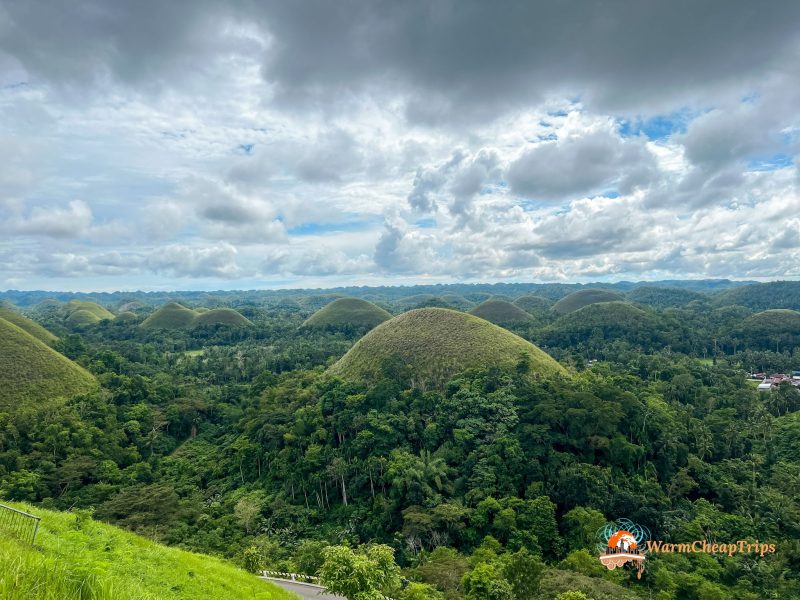

And so, our week-long New Year’s itinerary in the Philippines became Pintuyan – Bohol – Panglao, with Cebu used only as a base for the airport.
New Year in the Philippines: My One-Week Itinerary
With a week to spare, we organized our itinerary in a loop, arriving and departing from Cebu airport, which has direct flights from Tokyo with Cebu Pacific. We planned to be in Panglao on New Year’s Eve, just to be in the midst of the New Year’s celebrations on Alona Beach.
Day 0 – Arrival in Cebu
We left after work, arrived around 1 a.m., and took a transfer to our hotel for a few hours of sleep.
Day 1 – Transfer to Pintuyan
The transfer basically lasted all day. First, a ferry to Hilongos, then a local bus to Sogod, and finally the last two hours in a van to Pintuyan, where we arrived in the evening at the only guesthouse in the village. The owner insisted on taking us in his TukTuk to a small local restaurant on the beach where locals were celebrating. Good food, feet in the sand, and the inevitable Filipino karaoke.
Day 2 – Pintuyan
Today was supposed to be the big day for our boat trip to swim with whale sharks. Although we were here during their migration season, it had rained a lot the day before, and it was still drizzling in the morning. The rain disperses the plankton and, alas, we were not lucky enough to find any whale sharks in the area during our 3-hour boat trip. We later found out that shortly after we returned to port, one was spotted a short distance from the shore… what terrible luck!
I’ll tell you more about the whale sharks and how to get to Pintuyan in a dedicated post soon.
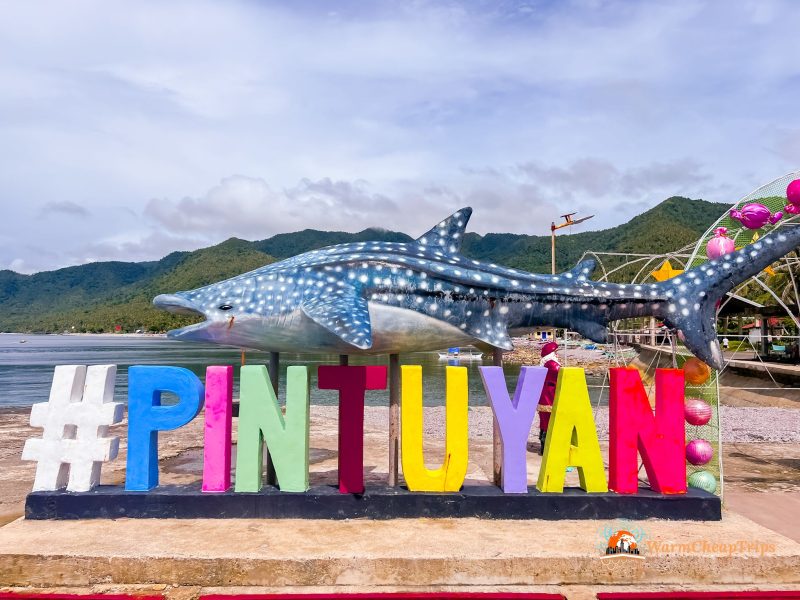

Day 3 – Travel to Bohol
We woke up well before dawn to take a van to Bato port, where ferries to Bohol depart. However, we would arrive at Ubay port, which is less touristy and further from the main attractions and Panglao, so we decided to book a private car for the whole day. Our driver took us to visit Bohol’s most famous sights, such as the Chocolate Hills and the Tarsier Sanctuary, before dropping us off at our ecolodge on the Loboc River. There we took a sunset kayak trip on the river and paddled in the dark to see the fireflies. It was a very exciting experience, and I’ll write more about it soon.
Day 4 – Travel to Panglao
It was December 31st and we made our way to the small island of Panglao, which is connected to Bohol by two bridges. We began to explore the island and its beaches, then took a nap to get ready for the evening, waiting for the start of 2025.
Alona Beach is definitely the “Place to Be” if you want to be with a lot of people for the countdown, beach music, and fireworks. After several years of spending New Year’s in Japan—without fireworks and with very sober and intimate celebrations—we really felt the desire to start the year with a bit more excitement. We didn’t want to overdo it, and waiting for midnight at Alona Beach, sitting by the sea with a cocktail in hand, surrounded by music from the local bars and a lot of people, was exactly what we wanted!


Day 5 & 6 – Panglao
We started the year lying on beautiful white beaches and swimming in crystal clear waters, eating on the beach and taking a boat trip (which didn’t thrill me). The atmosphere is much more “urban” and less wild than in El Nido, but if you’re looking for total relaxation on beautiful beaches, Panglao is the perfect destination.
Day 7 – Excursion to Pamilacan Island and Return to Cebu
Since our flight back from Cebu was at dawn the next day, we had a good half-day to spend in Panglao. So in the morning, we took a trip to Pamilacan Island, a stunning island just over an hour by boat from White Beach. At Pamilacan Island I probably had the most beautiful snorkeling experience ever, on a beautiful coral reef, among thousands of colorful fish and sea turtles, where we also saw a walo-walo, the dreaded and super venomous sea snake!
Then we reached Tagbilaran port to take the ferry to Cebu.
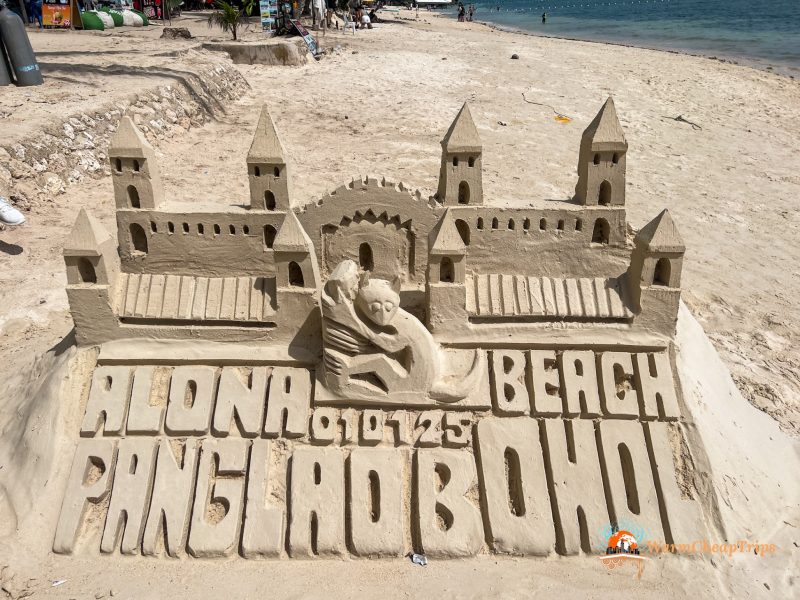
Itinerary in Pintuyan, Bohol, Panglao – Costs & Information
Even though this trip happened over New Year’s, prices were still reasonable. Unfortunately, because we booked late, many places were sold out. We found tourists, especially Koreans and Japanese at Alona Beach, and various Western travellers in Bohol, but it never felt overcrowded. The Philippines are probably still less mass-touristed overall, though places like Panglao are clearly ready for tourists. As I wrote after my first Philippines trip, things are generally very well organised for tourism and services — even though in Panglao I did encounter some “tourist trap” issues with excursions (a common problem that really angers local fishermen — I’ll explain more in the Panglao article).
Accommodations
We booked late (end of October) so many places were sold out, especially in Panglao. Still, I’m satisfied with what we booked and I’d recommend them.
-
Cebu: Here we only needed a place to spend a few hours sleeping on arrival (we would land after 1 a.m.) and before departure (a 6 a.m. flight). So, we were looking for a place close to the airport with the possibility of night check-in and check-out and, if possible, with a free airport shuttle. The Vivien’s Hotel was perfect—spacious, with a shower box and amenities available. A simple buffet breakfast with eggs, rice, and fruit is also included from the early morning. Less than €30 per night.
-
Pintuyan: D&G Transient House is practically the only option in Pintuyan! It’s a simple room with a single table to put things on and a basic bathroom with a shower head over the toilet that only has cold water (but that’s to be expected, we’re in a very local village!). The owners are super friendly and they have a small restaurant on the ground floor where you can have breakfast or request a meal for lunch or dinner. There isn’t a real menu… they usually ask what Filipino dish you want or they tell you what they’re cooking for themselves. We had breakfast, lunch, and dinner there, always eating what was available, and we always ate exquisitely for very little. Their chicken adobo was probably the best I’ve ever eaten! About €20 per night.
-
Bohol: I think I’ll write a dedicated post about our experience at the Water to Forest Ecolodge because we truly loved this ecolodge on the banks of the Loboc River. It’s at the end of a small, very local village, with stilt buildings that are basically without walls, but closed only by curtains. No air conditioning, but there are fans that work even after a nighttime power outage. We were surrounded by the sounds of nature (protected by a mosquito net around the bed). The facilities are shared, and it’s possible to organize SUP and Kayak trips, as well as other excursions. It was a true immersion in nature that I personally loved even more than The Isla Experience in El Nido, which, as similar as it was in concept, was perhaps relatively more “touristy.” Here too, meals are not included, but there is a cafe where you can order breakfast, lunch, and dinner. The prices are a bit higher, but the food is delicious and the portions are generous. Just over €25 per night.
-
Panglao: This stop was definitely the most touristy of this itinerary. Plus, we spent the New Year’s days here, so many places no longer had availability. Also, I preferred to avoid Alona Beach, but still be able to reach the beach on foot. Fortunately, we found a room at the D&B Bluestar Beach Resort, which, despite the name, is a normal hotel with fairly spacious rooms, a separate shower area from the rest of the bathroom, and a terrace or outdoor porch. It felt a bit like a seaside apartment, but without a kitchen! Right on the beach, there is also a small garden with hammocks and deck chairs under the trees for those who prefer to stay in the shade. Breakfast is included, and they also cook lunch and dinner dishes upon request, but honestly, the taste was quite poor. It’s possible to rent scooters and organize excursions. It was definitely the most expensive accommodation, about €60 per night, but we stayed from December 31st to January 3rd.


Transportation
-
Flight: From Tokyo, there are direct flights, and by flying with low-cost airlines like Cebu Pacific, a round-trip flight costs as much as a Tokyo-Kyoto round-trip Shinkansen! We paid less than €200 by booking in late October for late December.
-
Ferry Cebu – Hilongos: Finding information online about the ferries was not easy! Many sites are not up to date, and it’s practically impossible to book a ticket online. Generally, you have to go to the port or one of the various ferry company offices scattered throughout the Philippines, but since we arrived in the middle of the night, the only thing we could do was go to the port a couple of hours before departure and buy the tickets. For the sake of the schedule, we took the 11:00 a.m. ferry with Robble Shipping and only seated spots were left, which were cheaper, for 750 pesos per person. We also had to add 150 pesos for the port access fee. We arrived in Hilongos about 5 and a half hours later.
-
Ferry Bato – Ubay: In this case, we arrived at the port well in advance and took the first ferry departing at 8:30 a.m. that would arrive in Ubay shortly after 10 a.m. The company was Mama Mary Sea Transport, and here too we paid 750 pesos per person plus 150 pesos for port access.
-
Ferry Bohol – Cebu: This was the only ferry we managed to book online and pay by card, purchasing the ticket for the Ocean Jet through Klook for 870 pesos per person for an outside seat. Departures are frequent, about one every hour, and the crossing takes about a couple of hours. Then you have to add the usual 150 pesos for port access.
-
Bus Hilongos – Sogod: Onboard the ferry to Hilongos, there is a booth where you can buy bus tickets from the arrival port to Sogod. The cost is 150 pesos per person and the journey takes about 1 and a half hours.
-
Van Sogod – Pintuyan: From Sogod, frequent shared vans depart that reach Pintuyan in about an hour and a half, so you just have to wait at the terminal and pay the driver of the first van that arrives directly. If you’re not sure if a certain van goes to Pintuyan, you just have to ask the driver. 100 pesos per person.
-
Van Pintuyan – Ubay: For this transfer, we relied on the hotel in Pintuyan, and the owner booked a shared van for us that picked us up in front of the hotel at 4 a.m. and took us to Ubay port in just over two hours for 200 pesos per person.
-
Car with driver: After a lot of research, I found Albert’s company on Facebook, which offered us the best price. The excellent driver Joseph also gave us great advice on where to eat, on timings, and was super helpful. He came to pick us up at Ubay port, took us to visit Bohol, and then to the ecolodge. The next morning, he took us to Panglao, also with some stops along the way. The total for one and a half days was 6,500 pesos, a bit over our budget, but car rental with pick-up in Ubay would have cost us 5,500 pesos for a single day!

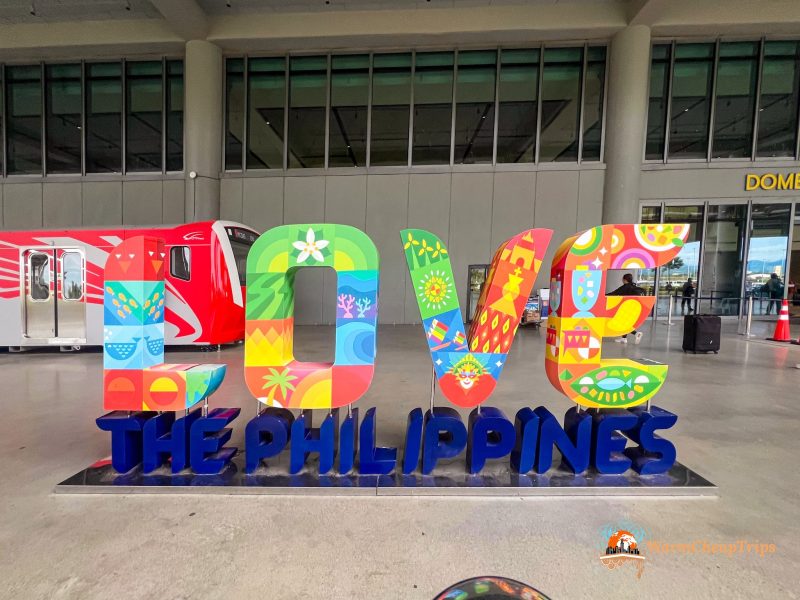
Activities & Excursions
Excursion to see whale sharks: To book it, you just have to go to the tourist office at the Pintuyan town hall that same morning. The boat trip lasts 3 hours and costs 1,700 pesos per boat (max 3 people), including a guide and spotter, plus a 250 pesos conservation fee per person. If you want to rent a mask and fins, add 300 pesos. There is no refund if you don’t spot any whale sharks.
Kayaking on the Loboc River: Booked directly through the Water to Forest Ecolodge, we chose the longest trip, a 3-hour one, where you go up the Loboc River to admire the sunset and then go down to the firefly viewing point when it gets dark. One of the most beautiful experiences I’ve ever had. It cost 1,100 pesos per kayak since we unfortunately had to use single kayaks because the double ones were already booked (otherwise it would have been a total of 1,900 pesos).
Excursion to Balicasag: This excursion was booked through the hotel in Panglao, with a private boat, for 2,500 pesos. In addition, there was a 300 pesos access fee per person and 150 pesos if you needed to rent a mask and snorkel.
Excursion to Pamilacan: Here we had negotiated a total price of 3,000 pesos, including the entrance fee, by bargaining with the vendors at Alona Beach. Unfortunately, the next morning the boat didn’t show up. When our contact finally answered us, he said the boat was late because of low tide, but after waiting an hour and no one showing up, we canceled the excursion and insisted on getting our deposit back. This required the intervention of the police, as advised by the local fishermen who were as furious as I was about this person’s terrible behavior, who seems to be one of the many who try to rip off tourists in Alona. Thanks again to these fishermen from White Beach, we managed to find a boat that took us to Pamilacan for 2,000 pesos, to which we added the 250 pesos entrance fee to the reserve per person, a total of 600 pesos for the snorkeling guide, and 150 pesos for the mask and snorkel rental.
Renting a scooter in Panglao cost us 50 pesos every 24 hours, while we spent from a few euros for more local food spots to less than €20 for an excellent grilled fish meal in Alona Beach.
The prices were in line with those of our previous Palawan itinerary, where Panglao, like El Nido, is generally a bit more expensive, while other stops and more local places are definitely super cheap.


This second trip will certainly not be our last to the Philippines. There are still so many places we want to see, and we particularly love this country. Also, I’m thinking of offering travel consulting for the Philippines in the future, in addition to my consulting service for Japan trips, as I’m getting to know this country more and more… Stay Tuned!
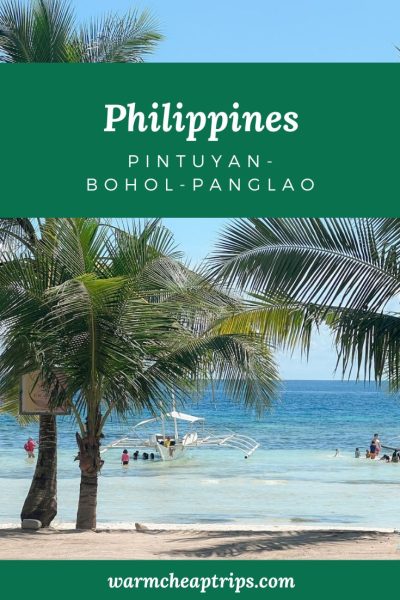

Did you find this article useful? Buy me a coffee 🙂



